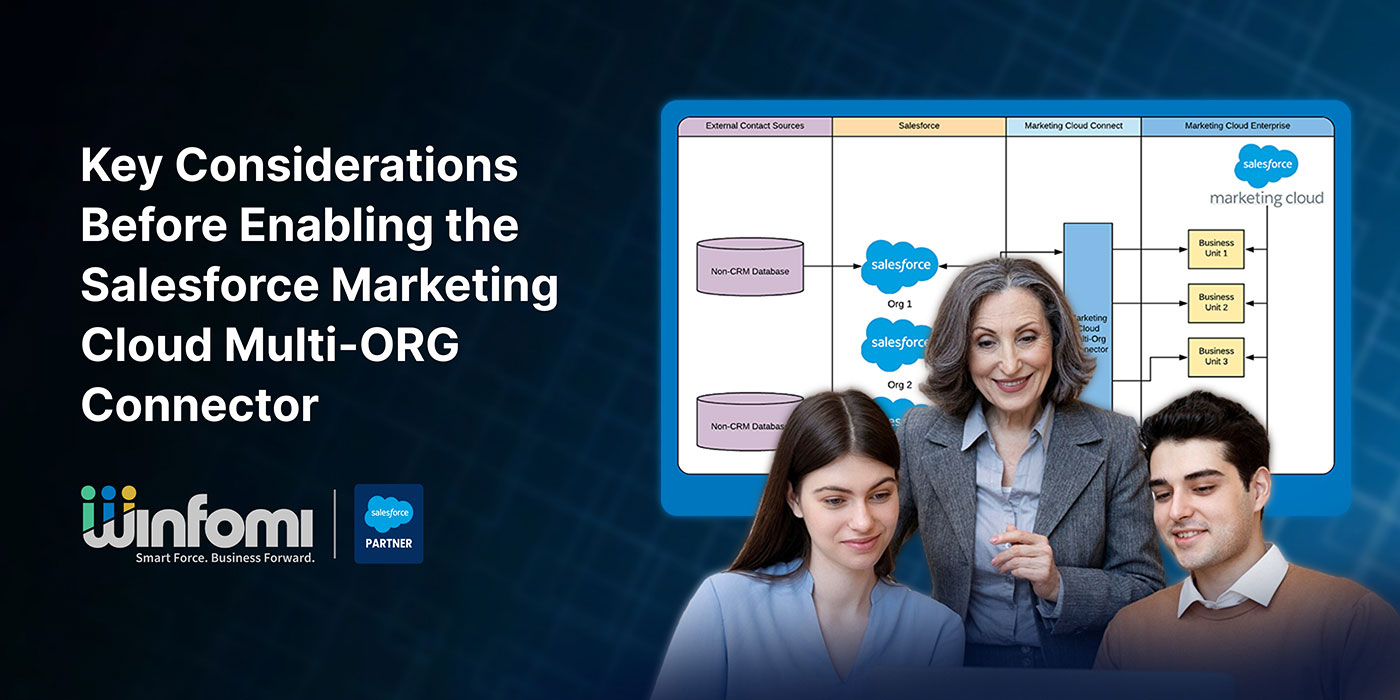

Share:
Table Of Contents
- Key Considerations Before Enabling the Salesforce Marketing Cloud Multi-ORG Connector
- What is the Salesforce Marketing Cloud Multi-Org Connector?
- Key Considerations Before Going Live with the Multi-Org Connector
- Steps to Enable Multi-Org Connector
- Are you ready to optimize your Salesforce Marketing Cloud with the Multi-Org Connector?
Key Considerations Before Enabling the Salesforce Marketing Cloud Multi-ORG Connector
Enabling the Salesforce Marketing Cloud Multi-Org Connector can significantly streamline your business’s marketing operations by connecting multiple Salesforce orgs to a single Marketing Cloud instance. However, before making this permanent decision, it’s essential to carefully assess various factors to ensure a seamless integration that avoids common challenges like data duplication or organizational misalignment.
At Winfomi, as a Salesforce Consulting Partner, we help businesses navigate the complexities of multi-org environments in Salesforce and optimize their Marketing Cloud for effective use. In this blog, we’ll outline the key considerations you need to keep in mind before enabling the Multi-Org Connector.
What is the Salesforce Marketing Cloud Multi-Org Connector?
The Multi-Org Connector allows businesses with multiple Salesforce orgs to connect them to one Salesforce Marketing Cloud (SFMC) instance. This enables central management of customer data from different business units, enhancing marketing capabilities across the board.
Enabling the Multi-Org Connector can greatly simplify marketing strategies for organizations with several Salesforce environments. However, it also comes with certain permanent changes and technical considerations that should be fully understood before proceeding.
Key Considerations Before Going Live with the Multi-Org Connector
1. Assess the Long-Term Need for Multiple Salesforce Orgs
Before enabling the Multi-Org Connector, it’s crucial to evaluate whether the use of multiple Salesforce orgs is temporary or permanent. The reason this is important is because once the Multi-Org Connector is enabled, it cannot be disabled. Therefore, if your organization anticipates consolidating orgs in the future, you may want to reconsider enabling the connector or carefully plan your strategy.
At Winfomi, we advise clients to consider their long-term business goals and scalability before making this decision. It’s essential to map out your data flow and the role each Salesforce org plays within your overall marketing strategy.
2. Eliminate Redundant Integrations to Avoid Data Duplication
Once the Multi-Org Connector is enabled, any non-Salesforce data integration processes that bring data into Marketing Cloud need to be disabled or removed. This is because having multiple integrations feeding data into the same Marketing Cloud instance can create data duplication issues.
For example, if data from both your existing integrations and Salesforce orgs are syncing to the same contacts and leads, you might end up with duplicate records, which can lead to inconsistent customer experiences and inaccurate reporting.
Winfomi’s expert consultants ensure that all existing integrations are reviewed and cleaned up before enabling the connector, preventing potential data duplication from occurring.
3. Subscriber Key Management
Another critical factor when enabling the Multi-Org Connector is ensuring Subscriber Key consistency across all Salesforce orgs. Since the Subscriber Key is the unique identifier for each customer or lead, any inconsistency or conflict in key management between Salesforce orgs can cause significant issues with Journey Builder, Automation Studio, and overall data accuracy in Marketing Cloud.
Winfomi helps clients set up robust data governance frameworks to ensure that Subscriber Keys are correctly managed across Salesforce orgs, preventing future data conflicts.
Steps to Enable Multi-Org Connector
If you’ve evaluated these considerations and decided to proceed with the Multi-Org Connector, here are the general steps to follow:
At Winfomi, we offer hands-on support to guide businesses through these steps, ensuring a smooth transition and a fully optimized Marketing Cloud instance.
Are you ready to optimize your Salesforce Marketing Cloud with the Multi-Org Connector?
At Winfomi, we offer expert guidance and implementation services to ensure your business is set up for long-term success. Contact us today to learn how we can help you streamline your marketing operations and drive growth through effective Salesforce integration.






